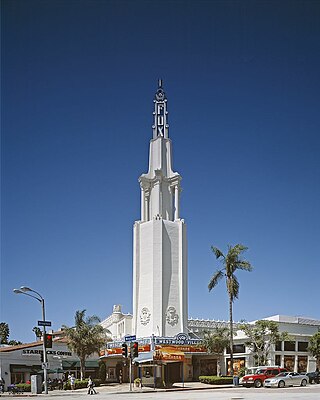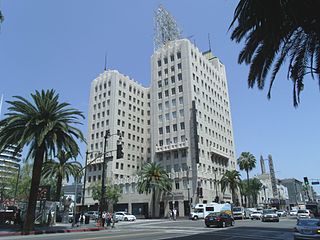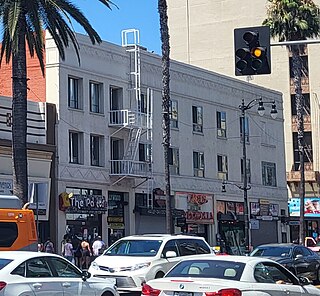
Hollywood and Vine, the intersection of Hollywood Boulevard and Vine Street in Hollywood, California, became known in the 1920s for its concentration of radio and movie-related businesses. The Hollywood Walk of Fame is centered on the intersection.

Hollywood Boulevard is a major east–west street in Los Angeles, California. It runs through the Hollywood, East Hollywood, Little Armenia, Thai Town, and Los Feliz districts. Its western terminus is at Sunset Plaza Drive in the Hollywood Hills and its eastern terminus is at Sunset Boulevard in Los Feliz. Hollywood Boulevard is famous for running through the tourist areas in central Hollywood, including attractions such as the Hollywood Walk of Fame and the Ovation Hollywood shopping and entertainment complex.

El Capitan Theatre is a fully restored movie palace at 6838 Hollywood Boulevard in the Hollywood neighborhood in Los Angeles, California, United States. The theater and adjacent Hollywood Masonic Temple are owned by The Walt Disney Company and serve as the venue for a majority of the Walt Disney Studios' film premieres.

The Pellissier Building and adjoining Wiltern Theatre is a 12-story, 155-foot (47 m) Art Deco landmark at the corner of Wilshire Boulevard and Western Avenue in Los Angeles, California. The entire complex is commonly referred to as the Wiltern Center. Clad in a blue-green glazed architectural terra-cotta tile and situated diagonal to the street corner, the complex is considered one of the finest examples of Art Deco architecture in the United States. The Wiltern building is owned privately, and the Wiltern Theatre is operated by Live Nation's Los Angeles division.

Highland Avenue is a north–south road in Los Angeles. It is a major thoroughfare between Cahuenga Boulevard/U.S. Route 101 in Hollywood at the north and Wilshire Boulevard in Mid-Wilshire at the south, and a residential street from Wilshire Boulevard to Washington Boulevard in Mid-City.

The Hollywood Pantages Theatre, formerly known as RKO Pantages Theatre and Fox-Pantages Theatre, also known as The Pantages, is a live theater and former movie theater located at 6233 Hollywood Boulevard, near Hollywood and Vine, in the Hollywood neighborhood of Los Angeles, California. Designed by architect B. Marcus Priteca, the theater was the last built by the vaudeville impresario Alexander Pantages and also the last movie palace built in Hollywood.
S. Charles Lee was an American architect recognized as one of the most prolific and distinguished motion picture theater designers on the West Coast.

Hollywood Masonic Temple, now known as the El Capitan Entertainment Centre and formerly known as Masonic Convention Hall, is a building on Hollywood Boulevard in the Hollywood neighborhood of Los Angeles, California, U.S., that was listed on the National Register of Historic Places in 1985.

Security Trust and Savings, also known as Security Trust, Security Pacific Bank, Security Bank Building, and Cahuenga Building, is a historic seven-story office building on the corner of Hollywood Boulevard and Cahuenga Boulevard in Hollywood, California. It is notable for its architecture, its history with Hollywood, and its association with fictional detective Phillip Marlowe.

The Regency Village Theatre is a historic, landmark cinema in Westwood, Los Angeles, California in the heart of the Mediterranean-themed shopping and cinema precinct, opposite the Fox Bruin Theater, near the University of California, Los Angeles (UCLA). The Regency Theaters chain lease ended in July 2024. The Westwood Village Theatre has been the site for many Hollywood movie premieres in Los Angeles. The seating capacity of the cinema is about 1,400.

Walker & Eisen (1919−1941) was an architectural partnership of architects Albert R. Walker and Percy A. Eisen in Los Angeles, California.

The Broadway Hollywood Building is a building in Los Angeles' Hollywood district. The building is situated in the Hollywood Walk of Fame monument area on the southwest corner of the intersection referred to as Hollywood and Vine, marking the intersection of Hollywood Boulevard and Vine Street. It was originally built as the B. H. Dyas Building in 1927. The Broadway Hollywood Building is referred to by both its main address of 6300 Hollywood Boulevard and its side address of 1645 Vine Street.

The Hollywood Museum is a museum located at North Highland Avenue in the Hollywood neighborhood of Los Angeles, California, United States, houses a collection of memorabilia from the history of American motion pictures and television. It is housed in the historic Max Factor Salon on Highland Avenue designed by American architect Simeon Charles Lee.

The Hollywood Boulevard Commercial and Entertainment District is a historic district that consists of twelve blocks between the 6200 and 7000 blocks of Hollywood Boulevard in Los Angeles, California. This strip of commercial and retail businesses, which includes more than 100 buildings, is recognized for its significance with the entertainment industry, particularly Hollywood and its golden age, and it also features the predominant architecture styles of the 1920s and 1930s.

Equitable Building of Hollywood, also known as the Bank of Hollywood Building and The Lofts at Hollywood and Vine, is a historic twelve-story former office building, now condominium located at 6253 W. Hollywood Boulevard, Hollywood, California, at the intersection of Hollywood and Vine.

The Hollywood Theater is a historic former movie theater located at 6764 Hollywood Boulevard in Hollywood, Los Angeles, California.

The Orient is a historic one-story retail building at 6626 W. Hollywood Boulevard in Hollywood, California.

The Hallmark Building is a historic two-story commercial building located at 6324 W. Hollywood Boulevard in Hollywood, California.

6806 Hollywood Boulevard is an unnamed historic building at 6806 W. Hollywood Boulevard in Hollywood, California.


















